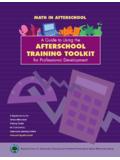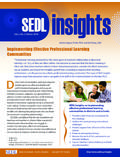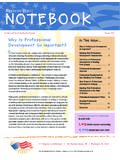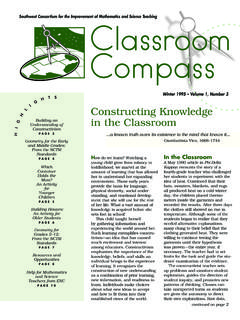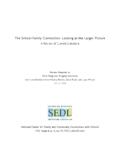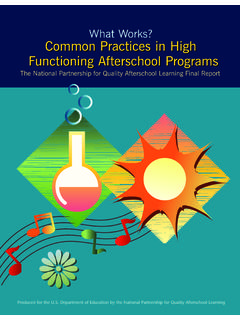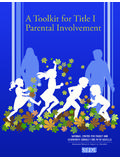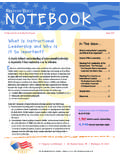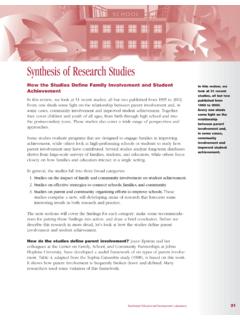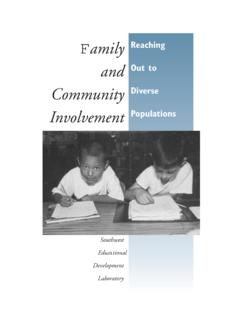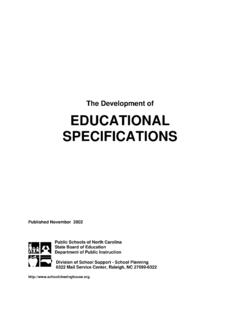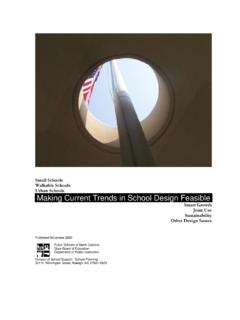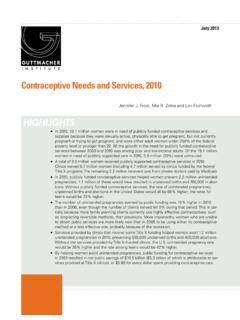Transcription of PROFESSIONAL LEARNING COMMUNITIES - SEDL
1 PROFESSIONAL LEARNINGCOMMUNITIESC ommunities of Continuous Inquiryand ImprovementShirley M. HordProfessional LEARNING COMMUNITIES : COMMUNITIES of Continuous Inquiry and ImprovementShirley M. HordSouthwest Educational Development Laboratory211 East Seventh StreetAustin,Texas 78701512/476-68611997 Copyright 1997 Southwest Educational Development Laboratory Reprinted April 2003 All rights to be reproduced without permission of the Educational Development Laboratory211 E. Seventh Street Austin,TX 78701voice: 512/476-6861fax: 512 Southwest Educational Development Laboratory. This publication was produced in whole or in part with funds from the Office of Educational Researchand Improvement, Department of Education, under contract # content herein does not necessarily reflect the views of the Department ofEducation, any other agency of the Government or any other of ContentsProfessional LEARNING COMMUNITIES : COMMUNITIES of Continuous Inquiry and Improvement.
2 2 Introduction ..6 The LEARNING Community Evolves .. 10 Attributes of PROFESSIONAL LEARNING COMMUNITIES .. 14 Supportive and Shared Leadership .. 14 Collective Creativity .. 18 Shared Values and Vision .. 19 Supportive Conditions .. 20 Shared Personal Practice .. 23 In Summary ..24 Outcome of PROFESSIONAL LEARNING COMMUNITIES for Students and Staffs .. 26 Linkage of Staff and Student Results .. 26 In Summary ..33 Processes for Developing LEARNING COMMUNITIES .. 36 Senge s Suggestions .. 36 Reinventing a School: A Case History .. 37 A Synthesis of Five Case Studies: Lesssons Learned .. 40 Other Suggestions and Ideas .. 48 In Summary ..53 Developing Other LEARNING Community Configurations .. 54In Conclusion .. 58 References ..622 PROFESSIONAL LEARNING COMMUNITIES : COMMUNITIES of Continuous Inquiry and ImprovementOver the past several decades, both the public and educationprofessionals have been vocal in their demands for new programs and practices in education.
3 Simultaneously, theseadvocates have acknowledged that educators must come to anintimate understanding of the process of change in order forimplementation to be successful and for the promises of newpractices to be realized. During this period, an abundance ofimprovement processes were introduced to school practition-ers in the hope that change would become less example, the effective schools research and its relatedschool improvement process provided the foundation formany schools around the globe to think about and work on school change. Subsequently, many other models and programs designed to improve student performance werehighly touted and the literature on successful school change proclaimedthe importance of the principal, the role and the actions ofthe principal on behalf of school improvement were widelystudied and reported.
4 Despite the time and resources devotedto the study of and attention to many other aspects of change3in education, disappointment in the amount and extent ofeducational improvement has been quick-fix mentality, especially prevalent in culture,resulted in many schools being poorly prepared for their plansfor change and therefore implementing change in a superficialand less-than-high-quality approach might be calledthe microwave oven theory of school improvement: Pop anew program in for four minutes with a hero principal tomanage it and improvement is then? Throughout my years of involvement in the school improve-ment process as a participating faculty member in schoolsthat sought increased benefits for students; as a student ofschool change and improvement, researching the factors thataffect change; and as an external facilitator, supporting schools efforts for improvement I have seen many examples ofunsuccessful I began to wonder if there wasn t a better way to do things.
5 During this time, I had the oppor-tunity to work in a LEARNING organization that matched PeterSenge s descriptions of such an organizational arrangement(1990). In that environment I experienced a nurturing culture4that encouraged a high level of staff collaboration in the effortto understand successful change , during a decade of valuable and productiveresearch and development work at the Southwest EducationalDevelopment Laboratory (SEDL), I was privileged to studythe improvement efforts of a school whose staff operated as a PROFESSIONAL LEARNING school s working conditions paralleled my earlier experience with a results of the SEDL study revealed a newmodel of school culture and organization that actively supported educational change and experiences stimulated my thinking about organiza-tions that value change as a means of realizing increased effectiveness.
6 In their research on improving the urban highschool, Miles and Louis (Louis & Miles, 1990; Miles & Louis,1990) cite the will and the skill for change. Much knowledge has been accrued regarding the skills necessary for change; what is not so clear is how to obtain the will the motivation, the interest, the action to do something with the knowledge that is seemed to me that if we could better understand the phenomenon of producing change-ready schools (those that valuechange and seekchanges that will improve theirschools), we could develop a more effective strategy for pursuing continuous school improvement. Jeannie Oakes,from her studies of school context, maintains: There is evidence that a PROFESSIONAL staff will work toward implementing strategies and programs to improve results (1989, p.)
7 194).PROFESSIONALLEARNINGCOMMUNITIEST hough not exhaustive,the review includesstories and reports ofresearch, most of whichare not available in theiroriginal form but arereported by theresearchers in booksand articles in populareducational encouragement about such school-based professionalstructures, and with the need for increased understanding ofthese structures, this literature review was reviewseeks (1) to define and describe what the literature is callingthe PROFESSIONAL LEARNING community; (2) to describe whathappens when a school staff studies, works, plans, and takesaction collectively on behalf of increased LEARNING for students;and (3) to reveal what is known about how to create suchcommunities of professionals in not exhaustive, the review includes stories andreports of research, most of which are not available in theiroriginal form but are reported by the researchers in books and articles in popular educational sources arereasonably accessible to educational practitioners at all levels of the system: state departments of education, institutions ofhigher education, intermediate service agencies, districtoffices, and local campuses.
8 It is this audience for whom thereview is intended in the hope that this information willchallenge and inspire all of us to make our schools moreeffective environments for both student and staff M. Hord1997 COMMUNITIES OFCONTINUOUSINQUIRY ANDIMPROVEMENT6 IntroductionThe term LEARNING communityis becoming well integrated intothe lexicon of American education. Some educators see it asextending classroom practice into the community, utilizingcommunity resources, both material and human. For others,it suggests bringing community personnel into the school to enhance the curriculum and LEARNING tasks for still others, it means having students, teachers, and administrators reciprocally engaged in , et al. (1993) proposed three related COMMUNITIES :(1) the PROFESSIONAL community of educators, (2) learningcommunities of teachers and students (and among students)both within and outside the classroom, and (3) the paper focuses on what Astuto and colleagueslabeled the PROFESSIONAL community of learners,in which theteachers in a school and its administrators continuously seekand share LEARNING , and act on their goal of theiractions is to enhance their effectiveness as professionals for thestudents benefit.
9 Thus, this arrangement may also be termedcommunities of continuous inquiry and a review of the literature, this paper will explore the concept and operationalization of professionallearning COMMUNITIES :7 What do PROFESSIONAL LEARNING COMMUNITIES look like andhow do they function? Why are such LEARNING COMMUNITIES important for bothstaff and students? How are LEARNING COMMUNITIES introduced and developedin schools as a new organizational arrangement?The reader should be aware that the literature selected for this report consists primarily of items that focus on buildinglearning COMMUNITIES of entire school staffs or whole highschool departments. MacMullen, in a review and analysis offactors influencing Coalition of Essential Schools reform(1996), concluded that a significant requirement for impact is the inclusion of the wholefaculty (emphasis added): indeveloping the vision, understanding the mission and purposefor which they are engaging, and deciding how to carry outtheir reform plans.
10 Similarly, in their article LEARNING FromSchool Restructuring, Peterson, McCarthey, and Elmore(1996) found that successful school restructuring involvedteachers meeting together as a whole staff or in focus on the system or the group as a whole does not,however, mean that the individual should be ignored, for, asHall and Hord (1987) emphasized, organizations do notchange individuals do. Fullan agreed that it is the individualwho provides the most effective route for accomplishing systemic change (1993); individuals change systems, actingseparately and together (1994).PROFESSIONALLEARNINGCOMMUNITIES10 The LEARNING Community EvolvesIn both the private corporate world and the public educationsector, attention in the 1980s began to focus on the influenceof work settings on workers.
